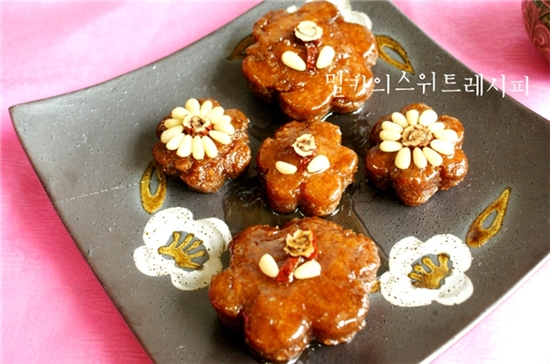
Yakgwa (Yakgwa
Before Chuseok, I made yakgwa, a traditional Korean traditional Korean sweets. We can't resist the temptation of sweet and chewy yakgwa with a cup of warm green tea as a palate after the memorial service and eating full Chuseok food.
6 serving
Within 120 minutes

밀키
- Ingredients
-
-
Flour500g
-
cinnamon powder1/2ts
-
ground pepperlittle
-
baking soda1/2ts
-
Eggs2ea
-
Cheongju1TS
-
Sesame oil7TS
-
Ginger1~1.5cup
-
jujubelittle
-
pine nutlittle
-
Ginger3cup
-
grain syrup3cup
-
Sugar2cup
-
Ginger100g
-
Water4cup
-
- Cooking Steps
-
STEP 1/6First, wash the ginger, peel it, grind it on a grater, add 4 cups of water, boil it down to about 3 cups, and sieve it to make ginger water.
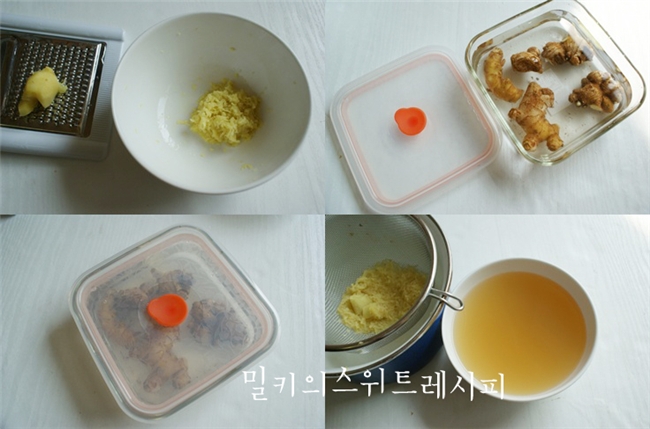 STEP 2/6Boil the syrup ingredients in a large, deep pot, and it boils quickly, so wait and see and boil it down to a concentration of starch syrup. Mix flour with flour and mix lightly with remaining ingredients.
STEP 2/6Boil the syrup ingredients in a large, deep pot, and it boils quickly, so wait and see and boil it down to a concentration of starch syrup. Mix flour with flour and mix lightly with remaining ingredients.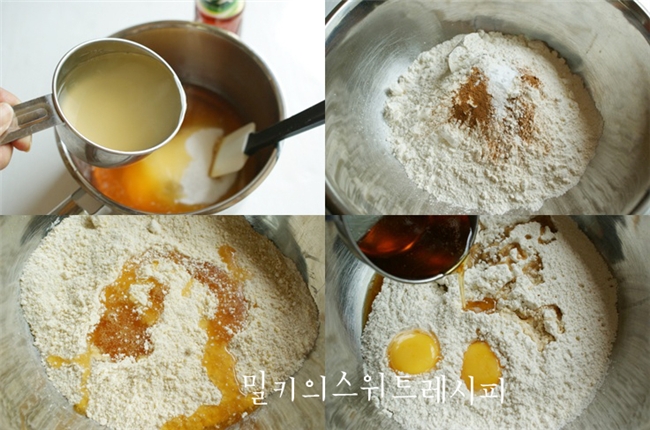 STEP 3/6Sift the mixed powder in a thick sieve twice, add ginger water, and knead it with a spatula. Add ginger water to the point where it feels a little thick, make the dough, put it in a plastic bag, and rest it in the refrigerator for more than an hour. (If you knead the dough for too long, it becomes a hard yakgwa.) It was uncomfortable to mix and drop it into a sieve. It would be convenient to put the powder on a sieve and mix it with the liquid.
STEP 3/6Sift the mixed powder in a thick sieve twice, add ginger water, and knead it with a spatula. Add ginger water to the point where it feels a little thick, make the dough, put it in a plastic bag, and rest it in the refrigerator for more than an hour. (If you knead the dough for too long, it becomes a hard yakgwa.) It was uncomfortable to mix and drop it into a sieve. It would be convenient to put the powder on a sieve and mix it with the liquid.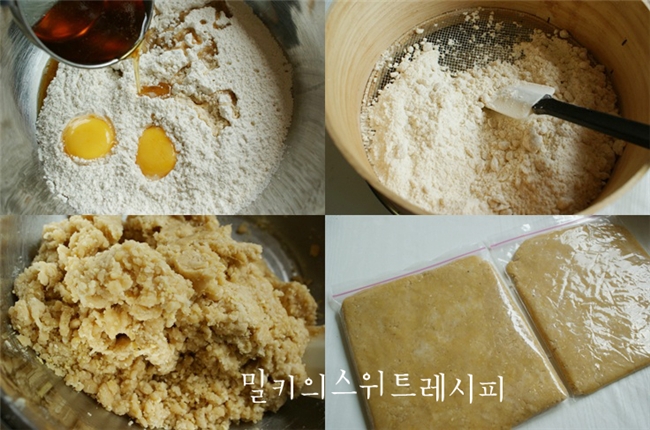 STEP 4/6Push it to 1cm thick with a plastic pack roll, cut it into a mold or cut it with a knife, poke a hole in the yakgwa with a fork, and fry it in 110 degrees boiling oil. When yakgwa comes up, fry it to 140 degrees. When the oil temperature is low, the yakgwa is loosened, and when it is high, it becomes hard and burns easily. As shown in the picture, it has to be cracked and fried so that the dough can penetrate the honey well and is done well.
STEP 4/6Push it to 1cm thick with a plastic pack roll, cut it into a mold or cut it with a knife, poke a hole in the yakgwa with a fork, and fry it in 110 degrees boiling oil. When yakgwa comes up, fry it to 140 degrees. When the oil temperature is low, the yakgwa is loosened, and when it is high, it becomes hard and burns easily. As shown in the picture, it has to be cracked and fried so that the dough can penetrate the honey well and is done well.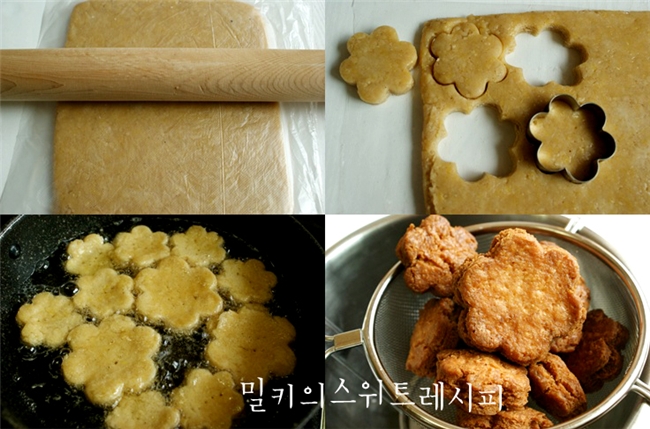 STEP 5/6You can put it in a container and seal it so that you can eat soft and delicious yakgwa after half a day. You know that the prettiest thing you made is put separately and put it on the table, right?
STEP 5/6You can put it in a container and seal it so that you can eat soft and delicious yakgwa after half a day. You know that the prettiest thing you made is put separately and put it on the table, right? STEP 6/6Even if you don't do push-folding, there are many layers of yakgwa that are soft inside. When I took a bite, I liked moist and soft medicine and sticky yakgwa, so I sprinkled a lot of honey and tasted it.
STEP 6/6Even if you don't do push-folding, there are many layers of yakgwa that are soft inside. When I took a bite, I liked moist and soft medicine and sticky yakgwa, so I sprinkled a lot of honey and tasted it. The leftover ginger dries or molds if you just store it in the refrigerator, but if you put it in a glass bottle or an airtight glass container and change the water once a week, it can be stored fresh for more than a month or two.
The leftover ginger dries or molds if you just store it in the refrigerator, but if you put it in a glass bottle or an airtight glass container and change the water once a week, it can be stored fresh for more than a month or two.
- Bulgogi Recommended recipe
-
-
1
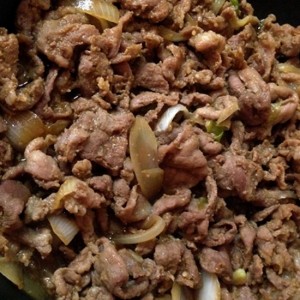 Pork Soy Sauce Bulgogi:: Pork Bulgogi, which you can enjoy a lot4.89(61)
Pork Soy Sauce Bulgogi:: Pork Bulgogi, which you can enjoy a lot4.89(61) -
2
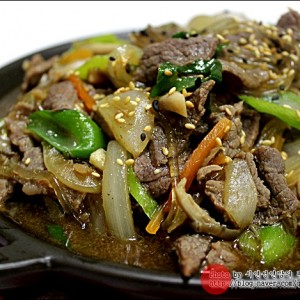 The representative of Korean food! Making delicious beef bulgogi4.86(21)
The representative of Korean food! Making delicious beef bulgogi4.86(21) -
3
 [Pork bulgogi with soy sauce]4.91(54)
[Pork bulgogi with soy sauce]4.91(54) -
4
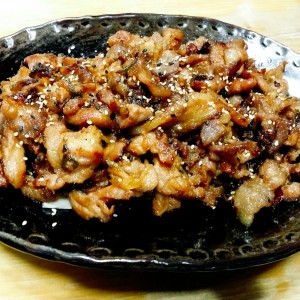 Fish sauce pork bulgogi. [Imitating Mr. Baek's fish sauce bulgog4.90(352)
Fish sauce pork bulgogi. [Imitating Mr. Baek's fish sauce bulgog4.90(352)
-
- Bibimbap Recommended recipe
-
-
1
 Making Hot Stone Pot Bibimbap with Vegetables - Yangssa4.79(14)
Making Hot Stone Pot Bibimbap with Vegetables - Yangssa4.79(14) -
2
 The menu that the actress ate. Super simple avocado pollack bibi4.98(48)
The menu that the actress ate. Super simple avocado pollack bibi4.98(48) -
3
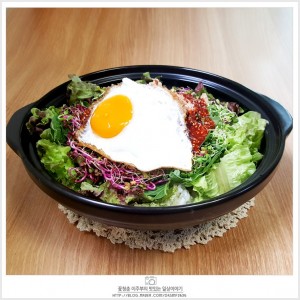 [One bowl recipe] Tuna sprout bibimbap, sprout bibimbap, seasoni4.93(68)
[One bowl recipe] Tuna sprout bibimbap, sprout bibimbap, seasoni4.93(68) -
4
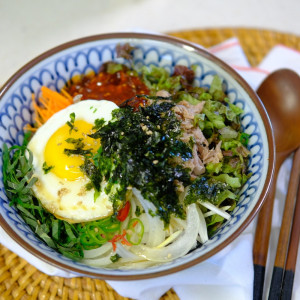 Tuna and vegetable bibimbap5.00(7)
Tuna and vegetable bibimbap5.00(7)
-